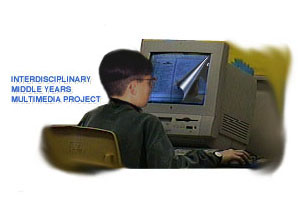
Pilot Project
Overview
The Interdisciplinary Middle Years Multimedia (IMYM) Project is a curriculum-based research and development project sponsored by Manitoba Education and Early Childhood Learning. The IMYM project was initiated in response to the identification of technology as a foundation skill area to be integrated throughout all Kindergarten to Senior 4 curricula. The purpose of the project is to develop an effective instructional model that supports integration of information technology with curriculum through an interdisciplinary approach to instruction at each grade level of the Middle Years.
Phase 1 of the project (IMYM5) was piloted in 24 pilot schools at Grade 5 during the 1996-97 school year. Phase 2 of the project (IMYM6) was piloted in 22 pilot schools at Grade 6 during the 1997-98 school year. Phase 3 of the project (IMYM7) is being piloted in 24 pilot schools at Grade 7 during the 1999-2000 school year. Phase 4 of the project (IMYM8) was piloted in 23 pilot schools at Grade 8 during the 2000-2001 school year. Pilot teachers were carefully selected based upon a number of criteria, the most important of those being the level of experience in interdisciplinary instruction and instructional innovation, not necessarily on their level of information technology literacy.
Qualitative evaluations based on an action research model are completed after each phase of the project. Evaluations for Phase1 (Grade5) and Phase 2 (Grade 6) have been completed.

Instructional Model
In each of the phases of the project, a model 6-8 week thematic concept-based interdisciplinary unit was developed to support teachers in integrating information technology into curriculum. Within these units, the core subject areas are blended around a theme or concept focused on a real world context. Learning becomes more meaningful for students in this environment because they are not just acquiring unrelated facts in different subject areas but are drawing connections among subject disciplines. Developing these connections requires the use of higher level thinking skills such as problem solving and critical analysis.
The instructional model being employed by this project shifts the role of the teacher from disseminator of information to a facilitator of active learning. A variety of instructional strategies are utilized by the teacher. For example, teachers use a multimedia computer and projection equipment for large group instruction. Alternatively, students work in collaborative groups at multimedia workstations, lab stations, or other learning experience centres around the classroom.
The use of information technology in the IMYM project facilitates the integration of curriculum and allows students to acquire the information technology skills and competencies necessary to function in today's society. The use of information technology allows middle years students to:
- develop knowledge, ability, and responsibility in the use of information technology
- acquire, organize, analyze, evaluate, and present information using appropriate information technology
- use information technology to expand their range and effectiveness of communication
- solve problems, accomplish tasks, and express creativity, both individually and collaboratively, using information technology
- understand the role and impact of information technology, and apply ethical, responsible, and legal standards in its use
In addition to the above, information technology allows teachers to differentiate instruction by addressing the variety of learning styles and multiple intelligences found in students. Multimedia can be designed to interface with any or all of the eight intelligences identified by Howard Gardner. Word processing software, for example, calls forth from its users a certain level of linguistic intelligence. Draw and paint software, on the other hand, more often requires spatial intelligence. Perhaps the most exciting technology application involving multiple intelligences is the area of hypertext. A hypertext project incorporating text (linguistic), illustrations (spatial), sound (musical or linguistic), and video (bodily kinesthetic) can be developed individually (intrapersonal ) or in groups (interpersonal). These hypermedia projects can be stored on various digital media such as CD-ROM, the Intranet, or the Internet to serve as part of the student's "electronic portfolio". These portfolios can be passed from one teacher to the next as part of an authentic assessment of the student's accomplishments during the year.
The instructional model used in this project was based on research which has been summarized in Curricular Connections: Elements of Integration in the Classroom (1997). This document was published by Manitoba Education and Early Childhood Learning and released in April 1997.


